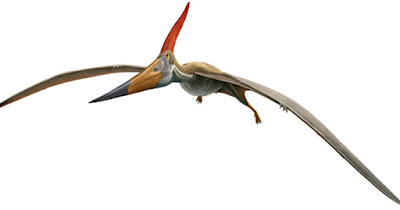The Percentage Increase/Decrease Method:
1. Take new number and subtract it from original number.
2. Take that number and divide it by the original number and multiply by 100.
3. That number will by your percentage increase or decrease if it's negative.
Ex.: "Stan's" Femur is 130 and has a body length of 12.2 meters. "Wyrex" has a femur length of 132.7 cm.
132.7 - 130 = 2.7.
2.7 divided by (represented by "/") and multiplied by (represented by "*") equals 2.1.
(2.7/130*100 = 2.1)
2.1 is your percentage increase, or 2.1% increase.
12.2 m + 2.1% = 12.5 meters for "Wyrex."
Links:
Percentage Increase/Decrease Method Links:
"Percentage Change - Percentage Increase and Decrease." SkillsYouNeed:
"Relative Increase." percentage.calculators.ro:
Example: Rhamphorhynchus:
Oxfordian-Tithonian if the late Jurassic period.
Place: Europe.
CM 11427 (Hone et al., 2013):
Wingspan: 104 cm. (Hone et al., 2013, pg. 167)
Skull: 9.6 cm. (Hone et al., 2013, pg. 166, Table 1)
Humerus (Right): 4.1 cm. (Hone et al., 2013, pg. 166, Table 1)
Femur (Left): 2.9 cm. (Hone et al., 2013, pg. 166, Table 1)
Link:
Hone et al., (2013):
https://www.researchgate.net/publication/270511722_An_annotated_and_illustrated_catalogue_of_Solnhofen_Upper_Jurassic_Germany_pterosaur_specimens_at_Carnegie_Museum_of_Natural_History
1. Pteranodon:
Time: Santonian of the late Cretaceous period: 86-84 million years ago.
Place: North America.
P. longiceps:
Males had the long, pointy-tipped crests while females had shorter crests. Males were also genuinely larger than females.
Bones (Oceans of Kansas; Originally from Wellnhofer, 1978) (Male individual):
Skull: 179 cm.
Humerus: 29.01 cm (at best). (Measured on 9/23/19 in Oceans of Kansas; Originally from Wellnhofer, 1978)
Rhamphorhynchus Specimen CM 11427:
Wingspan: 104 cm.
Skull: 9.6 cm.
Humerus (Right): 4.1 cm.
Femur (Left): 2.9 cm.
Skull:
9.6 - 179 = 169.4.
169.4/9.6*100 = 1,764.6% increase.
107 cm + 1,764.6% = 1995 cm/20 meters.
*Humerus:
29.01 - 4.1 = 24.91.
24.91/4.1*100 = 607.6% increase.
104 cm + 607.6% = 24 feet (736 cm/7.4 meters).
Pteranodon's Total Length: 24 feet (7.4 meters).
Link:
Oceans of Kansas:
Bones:
http://oceansofkansas.com/Pteranodon/Wellnhofer1978-2.jpg
Website:
http://oceansofkansas.com/Pteranodon.html
Differences in Males and Females:
Strauss (2019):
https://www.thoughtco.com/pteranodon-dinosaur-1091595
Tomkins et al., (2010) (pg. 144, Figure 1):
http://eprints.lincoln.ac.uk/15259/1/__ddat02_staffhome_jpartridge_653001.pdf
Time:
AMNH:
https://www.amnh.org/explore/news-blogs/on-exhibit-posts/thursday-s-pterosaur-pteranodon
Strauss (2019):
https://www.thoughtco.com/pteranodon-dinosaur-1091595
BHIGR:
http://www.bhigr.com/store/product.php?productid=115
Carpenter et al., (1995):
https://www.tandfonline.com/doi/abs/10.1080/02724634.1995.10011230
2. Quetzalcoatlus:
Time: Maastrichtian of the late Cretaceous period: 72-66 million years ago.
Place: North America.
Humerus from Sven Zach's Twitter page:
Length: 61.7 cm. (Measured on 9/23/19)
Pteranodon longiceps (Oceans of Kansas; Originally from Wellnhofer, 1978):
Humerus: 29.01 cm.
Wingspan: 7.4 meters.
61.7 - 29.01 = 32.69.
32.69/29.01*100 = 112.7% increase.
7.4 m + 112.7% = 52 feet (15.7 meters).
Quetzalcoatlus' Total Length: 52 feet (15.7 meters).
Link:
Humerus:
Image:
https://images.app.goo.gl/JURJpRGhZgTPE31p8
Sven Zach's Twitter Page:
https://twitter.com/dinosven/status/873142194844180480
Time and Place:
Kellner and Langston Jr. (1996):
https://www.tandfonline.com/doi/abs/10.1080/02724634.1996.10011310
Giant pterosaurs had short necks?
Time Periods:
International Chronostratigraphic Chart (2019 Version):
http://stratigraphy.org/ICSchart/ChronostratChart2019-05.jpg
http://stratigraphy.org/index.php/ics-chart-timescale



